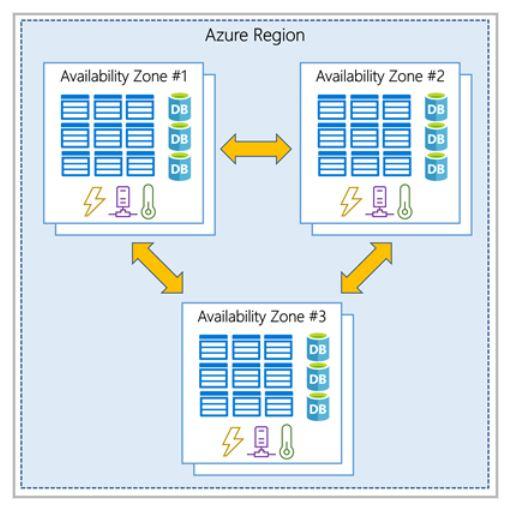Introduction
As cloud computing continues to gain traction, Microsoft Azure has emerged as a leading cloud platform, providing a comprehensive range of services to businesses and organizations worldwide. Azure’s global infrastructure is built upon a network of regions, availability zones, and region pairs, which are integral to ensuring high availability, scalability, and disaster recovery capabilities. In this article, we will explore Azure regions, availability zones, and region pairs to understand their significance in delivering robust cloud solutions.
Azure is made up of datacenters located around the globe. When you use a service or create a resource such as an SQL database or virtual machine (VM), you’re using physical equipment in one or more of these locations. These specific datacenters aren’t exposed to users directly. Instead, Azure organizes them into regions. As you’ll see later in this unit, some of these regions offer availability zones, which are different Azure datacenters within that region.
Azure Regions
Azure regions are geographically dispersed data center locations worldwide, each hosting multiple data centers. These regions enable customers to deploy their applications and services closer to their end-users, reducing latency and improving performance. Currently, Azure offers over 60 regions globally, including regions in North America, Europe, Asia, South America, and Australia.
Each Azure region operates independently, with its own power, cooling, networking infrastructure, and security measures. This autonomy ensures that an issue in one region does not impact services in other regions. Moreover, Azure regions are designed to meet specific compliance and data residency requirements, allowing customers to adhere to relevant regulations and ensure data sovereignty.
Why are regions important?
Azure has more global regions than any other cloud provider. These regions give you the flexibility to bring applications closer to your users no matter where they are. Global regions provide better scalability and redundancy. They also preserve data residency for your services.
Special Azure regions
In addition to the standard Azure regions, Microsoft also offers a few special Azure regions that cater to specific requirements and scenarios. These special regions provide unique capabilities or comply with specific regulatory needs. Let’s explore some of these special Azure regions:
- Azure Government Cloud: Azure Government Cloud is designed exclusively for U.S. federal, state, local, and tribal governments, as well as their partners. It meets stringent compliance and security requirements, including FedRAMP (Federal Risk and Authorization Management Program) High and DoD (Department of Defense) Impact Level 5, enabling government agencies to leverage cloud services while ensuring data protection and regulatory compliance.
- Azure China Cloud: Azure China Cloud operates independently of other Azure regions and is operated by local datacenter partners in China, namely 21Vianet and Microsoft. It provides cloud services to customers in China and complies with China’s regulatory requirements for data residency.
- Azure Germany Cloud: Azure Germany Cloud is operated by T-Systems, a trusted German data trustee, in partnership with Microsoft. It offers cloud services designed specifically for customers in Germany, providing data residency and compliance with strict German data protection regulations.
- Azure US Government: Azure US Government is a separate instance of Azure dedicated to meeting the specific requirements of U.S. federal, state, and local government agencies, as well as their partners. It adheres to stringent compliance standards, including FedRAMP High and DoD Impact Level 5, ensuring the highest levels of security and data protection for government workloads.
- Azure for Education: Azure for Education is a specialized offering tailored to the unique needs of educational institutions. It provides a cost-effective and scalable cloud platform for schools, colleges, and universities to deploy applications, store data, and support collaborative learning environments.
- Azure for Healthcare: Azure for Healthcare is a dedicated solution designed to address the unique challenges and regulatory requirements of the healthcare industry. It provides tools and services that enable secure data sharing, interoperability, and compliance with healthcare standards, such as the Health Insurance Portability and Accountability Act (HIPAA).
These special Azure regions are designed to meet specific compliance, regulatory, and industry requirements, enabling organizations in various sectors to leverage the power of Azure while ensuring data protection, security, and adherence to local regulations.
Azure Availability Zones
You want to ensure your services and data are redundant so you can protect your information if there’s a failure. When you host your infrastructure, setting up your own redundancy requires that you create duplicate hardware environments. Azure can help make your app highly available through availability zones.
Availability zones are physically separate datacenters within an Azure region. Each availability zone is made up of one or more datacenters equipped with independent power, cooling, and networking. An availability zone is set up to be an isolation boundary. If one zone goes down, the other continues working. Availability zones are connected through high-speed, private fiber-optic networks.
Within each Azure region, there are one or more availability zones (AZs). Availability zones are physically separate data centers within a region, each equipped with redundant power, cooling, and networking infrastructure. These AZs are connected through high-speed, low-latency networking, enabling resilient and fault-tolerant cloud deployments.
By distributing resources across multiple availability zones, customers can protect their applications and data from single points of failure. Azure ensures that each availability zone within a region is located far enough apart to minimize the risk of being affected by a single event, such as a power outage or natural disaster. This distributed architecture enhances the availability and reliability of applications, providing customers with the confidence that their services will remain operational even in the face of localized disruptions.

Supported regions
Not all regions have support for availability zones. The following regions support availability zones in Azure.
| Americas | Europe | Middle East | Africa | Asia Pacific |
|---|---|---|---|---|
| Brazil South | France Central | Qatar Central | South Africa North | Australia East |
| Canada Central | Germany West Central | UAE North | Central India | |
| Central US | North Europe | Japan East | ||
| East US | Norway East | Korea Central | ||
| East US 2 | UK South | Southeast Asia | ||
| South Central US | West Europe | East Asia | ||
| US Gov Virginia | Sweden Central | China North 3 | ||
| West US 2 | Switzerland North | |||
| West US 3 | Poland Central |
Use availability zones in your apps
Using availability zones in your applications is highly recommended to enhance the availability and resilience of your cloud deployments. Availability zones (AZs) are physically separate data centers within an Azure region, each equipped with independent power, cooling, and networking infrastructure. By distributing your resources across multiple availability zones, you can protect your applications from single points of failure and ensure high availability.
Here are some key considerations for leveraging availability zones in your applications:
- Fault tolerance: By deploying your application across multiple availability zones, you ensure that if one zone experiences an outage or disruption, your application can seamlessly failover to another zone. This reduces the risk of downtime and ensures uninterrupted service for your users.
- Load balancing: Availability zones can be leveraged for load balancing purposes. You can distribute your application’s traffic across multiple zones to handle increased load and achieve optimal performance. Azure Load Balancer and Azure Traffic Manager are two services that can assist in load balancing across availability zones.
- High availability databases: If your application relies on a database, consider using Azure SQL Database or Azure Database for PostgreSQL or MySQL with zone redundancy enabled. This feature replicates your database across multiple availability zones within a region, ensuring data durability and minimizing downtime in case of zone failures.
- Disaster recovery: Availability zones are crucial for implementing robust disaster recovery strategies. By pairing regions and replicating data across them, you can establish a failover mechanism in case of a catastrophic event affecting an entire region. This ensures business continuity and minimizes data loss.
- Azure Virtual Machines: When provisioning virtual machines (VMs), you can deploy them across availability zones to distribute your workload. This approach provides resiliency and fault tolerance at the infrastructure level. Azure Virtual Machine Scale Sets can help manage and automatically distribute VM instances across availability zones.
- Data redundancy: If data redundancy is a critical requirement for your application, you can replicate your data across availability zones using Azure Storage redundancy options such as Zone-redundant Storage (ZRS) or Geo-redundant Storage (GRS). This ensures that your data is stored in multiple physically separate locations, enhancing durability and availability.
It’s important to note that leveraging availability zones may require additional considerations, such as data synchronization, networking configuration, and load balancing setup. You should also regularly test failover scenarios and monitor the health of your applications to ensure they can gracefully handle zone failures.
By designing your applications with availability zones in mind, you can significantly improve their resilience, mitigate the risk of downtime, and deliver a highly available and robust experience for your users.
Availability zones are primarily for VMs, managed disks, load balancers, and SQL databases. The following categories of Azure services support availability zones:
- Zonal services: You pin the resource to a specific zone (for example, VMs, managed disks, IP addresses).
- Zone-redundant services: The platform replicates automatically across zones (for example, zone-redundant storage, SQL Database).
- Non-regional services: Services are always available from Azure geographies and are resilient to zone-wide outages and region-wide outages.
Azure Region Pairs
Region pairs in Azure are the pairing of two geographically separated regions into a single unit. These pairs are designed to provide comprehensive disaster recovery capabilities for applications and data. Each region pair consists of a primary region and a secondary region, often located hundreds of miles apart to minimize the impact of regional disasters.
Each Azure region is always paired with another region within the same geography (such as US, Europe, or Asia) at least 300 miles away. This approach allows for the replication of resources (such as VM storage) across geography to help reduce the likelihood of interruptions due to catastrophic events. For example, events such as natural disasters, civil unrest, power outages, or physical network outages that affect multiple zones at once. If a region in a pair was affected by a natural disaster, services would automatically failover to the other region in its region pair.
The primary region serves as the customer’s primary deployment location, while the secondary region acts as a backup or recovery site. Azure ensures synchronous replication of data between the paired regions, enabling near real-time data redundancy. In the event of a regional outage or disruption, customers can failover their services to the secondary region, minimizing downtime and ensuring business continuity.
Region pairs also facilitate compliance with various industry standards and regulations. For instance, customers who require data redundancy within a specific geographic boundary can utilize region pairs to meet their compliance needs.
Examples of region pairs in Azure are West US paired with East US and SouthEast Asia paired with East Asia.

Azure region pairs offer several advantages in terms of disaster recovery, business continuity, and data durability. Here are the key advantages of Azure region pairs:
- Geographic Redundancy: Azure region pairs consist of two Azure regions located in different geographic areas, typically separated by a significant distance. This geographic separation helps ensure that your applications and data are protected from regional-level disasters, such as natural calamities, power outages, or other disruptive events.
- Data Replication: Azure region pairs provide the capability to replicate your data and resources between the paired regions. This replication ensures that your data remains available and consistent even if an entire region becomes unavailable. By synchronously or asynchronously replicating your data to the paired region, you can achieve data redundancy and mitigate the risk of data loss.
- High Availability: Region pairs enable you to design highly available architectures by distributing your applications and services across the paired regions. By deploying resources in both regions, you can establish failover mechanisms that automatically redirect traffic and workload to the paired region in the event of an outage or disruption in the primary region. This ensures uninterrupted service and minimizes downtime for your users.
- Disaster Recovery: Azure region pairs play a crucial role in disaster recovery strategies. In the event of a catastrophic failure or prolonged outage in a primary region, you can failover your applications and services to the paired region. This allows for quick recovery and ensures business continuity. Azure provides services like Azure Site Recovery (ASR) that simplify and automate the failover and failback processes between region pairs.
- Compliance and Data Residency: Azure region pairs offer options for data residency and compliance requirements. By replicating data to a region within the same geographic area, you can meet regulatory requirements that mandate data storage and processing within specific jurisdictions.
- Testing and Development: Region pairs can be leveraged for testing and development purposes. You can deploy resources in one region for production workloads and use the paired region for testing, validation, or development activities. This segregation helps maintain the integrity of the production environment while enabling efficient development and testing processes.
By leveraging Azure region pairs, organizations can enhance the resilience of their applications, protect their data, and ensure continuous operation even in the face of regional disruptions or disasters.
Conclusion
Azure regions, availability zones, and region pairs form the backbone of Microsoft Azure’s global infrastructure, enabling customers to build resilient and scalable cloud solutions. By leveraging the distributed nature of Azure regions and deploying resources across availability zones, businesses can ensure high availability and fault tolerance for their applications. Region pairs further enhance disaster recovery capabilities, allowing customers to quickly recover from regional outages or disruptions.
As organizations increasingly embrace cloud technologies, understanding Azure’s regions, availability zones, and region pairs becomes vital for designing robust and reliable cloud architectures. By leveraging the capabilities offered by Azure’s global infrastructure, businesses can confidently deploy their applications, protect their data, and achieve their desired levels of performance, availability, and compliance.








